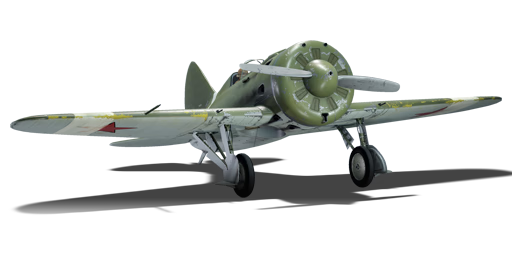



The I-16 type 10 is a Soviet fighter. It was introduced in Update 1.45 "Steel Generals".
The I-16 Type 10 is equipped with four ShKAS machine guns chambered with the 7.62 x 54R cartridge, a cyclic rate of fire of 1,800 rpm. Two of them are mounted above the engine cowling and carry 650 RPG while other pair are mounted on the wings and have ammo load out of 900 rounds each. Historically the cowling mounted machine guns were synchronized to propeller spin resulting in a rate of fire of 1,460 rpm, the preliminary analysis seems to suggest that the synchronization gear is not modelled in the game and all four guns fire at 1,800 rpm.
While the increase of the armament by double may seem already quite an upgrade it has to be remembered that the extra pair of light machine guns are fitted in the cowling, which means that convergence range is not quite as important for effective fire when compared to the wing mounted only armament of the Type 5. Of course, it is still not to be neglected, and as with any light machine gun armed vehicle, a relatively close gun convergence range of 150 to 400 m is generally more effective. As with any other ShKAS machine gun armed aircraft, jamming due to overheat can be a serious threat although not quite as crippling as it is with the Type 5s (losing a machine gun in Type 5 means losing 1/2 of your firepower, losing one in Type 10 mean losing "only" 1/4 of your firepower). Unlike the I-16 Type 5, Type 10 is equipped with a PAK-1 reflector sight making overall aiming at close range easier than with a telescopic sight. It has to be kept in mind that in spite of the increased weight and more powerful armament, the lack of trimmer control and plane's inherent stability make it a rather lousy gun platform compared to latter heavier aircraft.
Unlike the Type 5 that precedes it, Type 10 does have the ability to mount armament on its external pylons. This armament in-game is limited to six wing-mounted RS-82 rockets, unfortunately these rockets had a somewhat lacklustre performance against armour (although they are a still a considerable upgrade compared to just light machine guns) and can be somewhat effective against exposed ground targets and enemy aircraft with the use of good aim and a bit of luck. Still, this armament is overall unreliable and it should only be taken in very specific situations if air combat is expected.
flaps
flaps
flaps
brake
| Belt | Belt filling | Armor penetration (mm) at a distance: | |||||
|---|---|---|---|---|---|---|---|
| 10 m | 100 m | 500 m | 1000 m | 1500 m | 2000 m | ||
| T/Ball/Ball/AP-I/AI | 13 | 12 | 7 | 3 | 2 | 0 | |
| AP-I/AI/API-T | 13 | 12 | 7 | 3 | 2 | 0 | |
| AP-I/API-T | 13 | 12 | 7 | 3 | 2 | 0 | |
| AP-I/AP-I/AP-I/AI | 13 | 12 | 7 | 3 | 2 | 0 | |












Flight performance | |
|---|---|
Survivability |
|---|
Weaponry | |
|---|---|